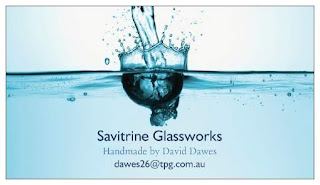Please visit the site and check out the items for sale.
Quite an impressive body of work so far even if I say so myself!!
Monday, September 26, 2011
Friday, September 23, 2011
Making Luto - Moulds part 2
Well I knew it was ambitious. The boat mould cracked even before it got to the kiln so now it is smashed up in a bag ready to be used as luto or grog (filler material). So undeterred I then made up seven moulds slightly smaller and measured the Hydrocal and Silica very carefully. Success I thought as they air dried perfectly! But they cracked when being cured in the kiln even though it was only fired to 400 deg C. They have been smashed into another luto bag. Don't you just love recycling?!
I have two more boat moulds made and am thinking of binding them with stainless steel wire and just firing them with glass in to see what happens. I suspect, inevitably, they will go into a third bag or the garbage can. Next step will be to actually make a boat with earthenware or porcelain clay, fire it and then use as a mould. Next update in about a month on my mouldy progress.
To cheer myself up I made the above platter which will be a raffle prize at my son's school in late October. Can't get a mould to work but my fusing and slumping is improving all the time.
Sunday, September 4, 2011
Making Moulds
My first real mould making experience and why not make it ambitious? I wanted to make a boat shaped piece of fused glass and used a porcelain serving bowl as the 'blank'. After filling it with Kleen clay and laying upside down on a board I covered it with mould release (dishwashing liquid I think despite the price!) and then built a dam wall around it with flexible perspex.
The mould material was a mixture of 6 parts Hydrocal (Calcium sulphate gypsum), 2 parts Silica powder and 1 part Grog (fine particles of old broken clay moulds). First I put enough clean water in a bucket to cover the mould plus a bit more to allow for absorption. The plaster mix was then spread onto the water a handful at a time. The first handfuls absorb the water and about twenty handfuls later the powder stayed dry as the rest had absorbed most of the water. The mix can be left for about ten minutes before use like this.
I mixed by hand until it coated my hand like full cream and there were no more lumps. Left for about 10 minutes until it started to set and then poured over the mould while pounding the board to eliminate as much air as possible. Whilst the plaster was setting I cleaned up all the utensils - into the garden and never down the sink as the plaster hardens in the pipes.
About 40 minutes later the plaster had set and I removed the perspex dam and the original porcelain 'blank' piece so that it can be used again. The ceramic mould is very heavy so it will need 7 days to air dry before drilling (vent) holes in the base and firing it at 120 degrees Centigrade for 3 hours and 480 deg C for 1 hour then cool to room temperature. Then, so long as it does not crack or break, I will fill with frits, stringers and scrap glass and fire my first boat. The plan is then to suspend it from a frame like a lifeboat. Keep you posted when it's finished and will post the 'boat series' as and when they come out of the kiln.
Subscribe to:
Posts (Atom)


